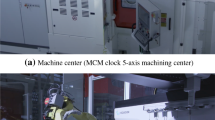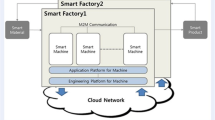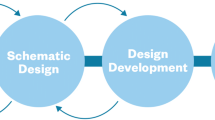Abstract
The generation of sequence planning becomes a difficult task as the number of part increases. As a consequence, dividing the complex product into multiple subassemblies which contain relatively few parts will decrease sequence planning difficulty. In the process of product assembly, semantic knowledge is an important basis for subassembly identification. Therefore, a semantic knowledge-driven subassembly identification framework is proposed. Generating information and knowledge during product design stage can be effectively utilized to become a variety of input constraints in the process of subassembly identification, including non-geometric structure constraints and assembly process constraints. Firstly, an assembly semantic model framework is constructed by mapping among spatial objects, assembly process and assembly relations, which are defined with Web Ontology Language (OWL) assertions. Next, the datum parts can be determined according to assembly directed graph. The influence of non-geometric structure attributes and assembly process factors on the assemblability was quantitatively expressed in semantics, and the characterization values and comprehensive weight value were deduced through Semantics Web Rule Language (SWRL) rules to construct weighted assembly directed graph. Based on this, simplifying weighted assembly directed graph through node merging and assembling is utilized to identify subassembly. Finally, the effectiveness of the framework is verified by transmission subassembly identification. The main contribution is presenting an ontology-based approach for subassembly identification, which can provide a feasible solution for the issue that mathematics-based subassembly identification approaches have great difficulty in explicitly representing assembly experience and knowledge.













Similar content being viewed by others
References
Demoly F, Yan XT, Eynard B, Rivest L, Gomes S (2011) An assembly oriented design framework for product structure engineering and assembly sequence planning. Robot Comput Integr Manuf 27(1):33–46
Ou LM, Xu X (2013) Relationship matrix based automatic assembly sequence generation from a CAD model. Comput Aided Des 45(7):1053–1067
Su Q, Lai SJ (2010) 3D geometric constraint analysis and its application on the spatial assembly sequence planning. Int J Prod Res 48(5):1395–1414
Lu HJ, Zhen HQ, Mi WJ, Huang YF (2015) A physically based approach with human-machine cooperation concept to generate assembly sequences. Comput Ind Eng 89:213–225
Kardos C, Kovacs A, Vancza J (2017) Decomposition approach to optimal feature-based assembly planning. CIRP Ann-Manuf Technol 66(1):417–420
Ghandi S, Masehian E (2015) Assembly sequence planning of rigid and flexible parts. J Manuf Syst 36:128–146
Ong NS, Wong YC (1999) Automatic subassembly detection from a product model for disassembly sequence generation. Int J Adv Manuf Technol 15(6):425–431
Trigui M, Belhadj I, Benamara A (2017) Disassembly plan approach based on subassembly concept. Int J Adv Manuf Technol 90(1-4):219–231
Belhadj I, Trigui M, Benamara A (2016) Subassembly generation algorithm from a CAD model. Int J Adv Manuf Technol 87(9-12):2829–2840
Kashkoush M, ElMaraghy H (2015) Knowledge-based model for constructing master assembly sequence. J Manuf Syst 34:43–52
Defazio TL, Whitney DE (1987) Simplified generation of all mechanical assembly sequences. IEEE J Robot Auto 3(6):640–658
Zhong YR, Jiang CH, Qin YC, Yang GY, Huang MF, Luo XN (2019) Automatically generating assembly sequences with an ontology-based approach. Assem Autom 40(2):319–334
Xing YF, Wang YS (2012) Assembly sequence planning based on a hybrid particle swarm optimisation and genetic algorithm. Int J Prod Res 50(24):7303–7312
Kara S, Pornprasitpol P, Kaebernick H (2006) Selective disassembly sequencing: A methodology for the disassembly of end-of-life products. CIRP Ann-Manuf Technol 55(1):37–40
Jin S, Cai W, Lai XM, Lin ZQ (2010) Design automation and optimization of assembly sequences for complex mechanical systems. Int J Adv Manuf Technol 48(9-12):1045–1059
Chakrabarty S, Wolter J (1997) A structure-oriented approach to assembly sequence planning. IEEE Trans Robot Autom 13(1):14–29
Yin ZP, Ding H, Li HX, Xiong YL (2003) A connector-based hierarchical approach to assembly sequence planning for mechanical assemblies. Comput Aided Des 35(1):37–56
Gupta S, Krishnan V (1998) Product family-based assembly sequence design methodology. IIE Trans 30(10):933–945
Su Q (2007) Computer aided geometric feasible assembly sequence planning and optimizing. Int J Adv Manuf Technol 33(1-2):48–58
Zhou XM, Du PG (2008) A model-based approach to assembly sequence planning. Int J Adv Manuf Technol 39(9-10):983–994
Santochi M, Dini G (1992) Computer-aided planning of assembly operations - the selection of assembly sequences. Robot Comput Integr Manuf 9(6):439–446
Bai YW, Chen ZN, Bin HZ, Hun J (2005) An effective integration approach toward assembly sequence planning and evaluation. Int J Adv Manuf Technol 27(1-2):96–105
Sanfilippo EM, Belkadi F, Bernard A (2019) Ontology-based knowledge representation for additive manufacturing. Comput Ind 109:182–194
Wang GF, Tian XT, Geng JH, Guo B (2015) A knowledge accumulation approach based on bilayer social wiki network for computer-aided process innovation. Int J Prod Res 53(8):2365–2382
Xing XJ, Zhong BT, Luo HB, Li H, Wu HT (2019) Ontology for safety risk identification in metro construction. Comput Ind 109:14–30
He W, Wang FK, Akula V (2017) Managing extracted knowledge from big social media data for business decision making. J Knowl Manag 21(2):275–294
Gao J, Bernard A (2018) An overview of knowledge sharing in new product development. Int J Adv Manuf Technol 94(5-8):1545–1550
Qiao LH, Qie YF, Zhu ZW, Zhu YX, Zaman UKU, Anwer N (2018) An ontology-based modelling and reasoning framework for assembly sequence planning. Int J Adv Manuf Technol 94(9-12):4187–4197
Qin YC, Lu WL, Qi QF, Li TK, Huang MF, Scott PJ, Jiang XQ (2017) Explicitly representing the semantics of composite positional tolerance for patterns of holes. Int J Adv Manuf Technol 90(5-8):2121–2137
Qin YC, Lu WL, Qi QF, Liu XJ, Huang MF, Scott PJ, Jiang XQ (2018) Towards an ontology-supported case-based reasoning approach for computer-aided tolerance specification. Knowl-Based Syst 141:129–147
Zhong YR, Qin YC, Huang MF, Lu WL, Gao WX, Du YL (2013) Automatically generating assembly tolerance types with an ontology-based approach. Comput Aided Des 45(11):1253–1275
Sarigecili MI, Roy U, Rachuri S (2014) Interpreting the semantics of GD&T specifications of a product for tolerance analysis. Comput Aided Des 47:72–84
Shi XL, Tian XT, Wang GF (2020) Screening product tolerances considering semantic variation propagation and fusion for assembly precision analysis. Int J Precis Eng Manuf 21:1259–1278
Shi XL, Tian XT, Wang GF, Zhang M, Zhao DP (2018) A simplified model for assembly precision information of complex products based on tolerance semantic relations. Sustainability 10(12):4482
Kardos C, Vancza J (2018) Mixed-initiative assembly planning combining geometric reasoning and constrained optimization. CIRP Ann-Manuf Technol 67(1):463–466
Acknowledgments
This work was partially supported by the Natural Science Basic Research Project of Shaanxi Province, China (Grant Nos. 2019JM-073 and 2019JM-435) and the China Postdoctoral Science Foundation (Grant No. 2018M633439). The authors would also like to thank the editors and anonymous referees for their insightful comments and suggestions.
Author information
Authors and Affiliations
Corresponding author
Additional information
Publisher’s note
Springer Nature remains neutral with regard to jurisdictional claims in published maps and institutional affiliations.
Rights and permissions
About this article
Cite this article
Shi, X., Tian, X., Wang, G. et al. Semantic-based subassembly identification considering non-geometric structure attributes and assembly process factors. Int J Adv Manuf Technol 110, 439–455 (2020). https://doi.org/10.1007/s00170-020-05881-y
Received:
Accepted:
Published:
Issue Date:
DOI: https://doi.org/10.1007/s00170-020-05881-y




